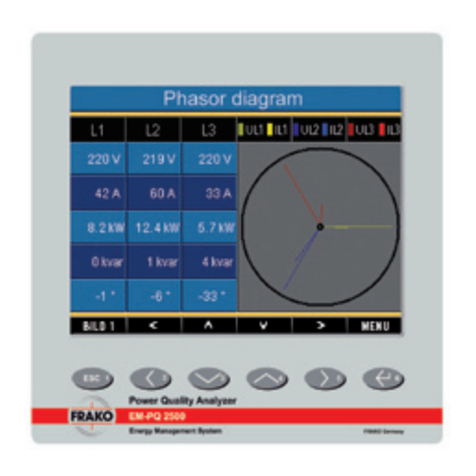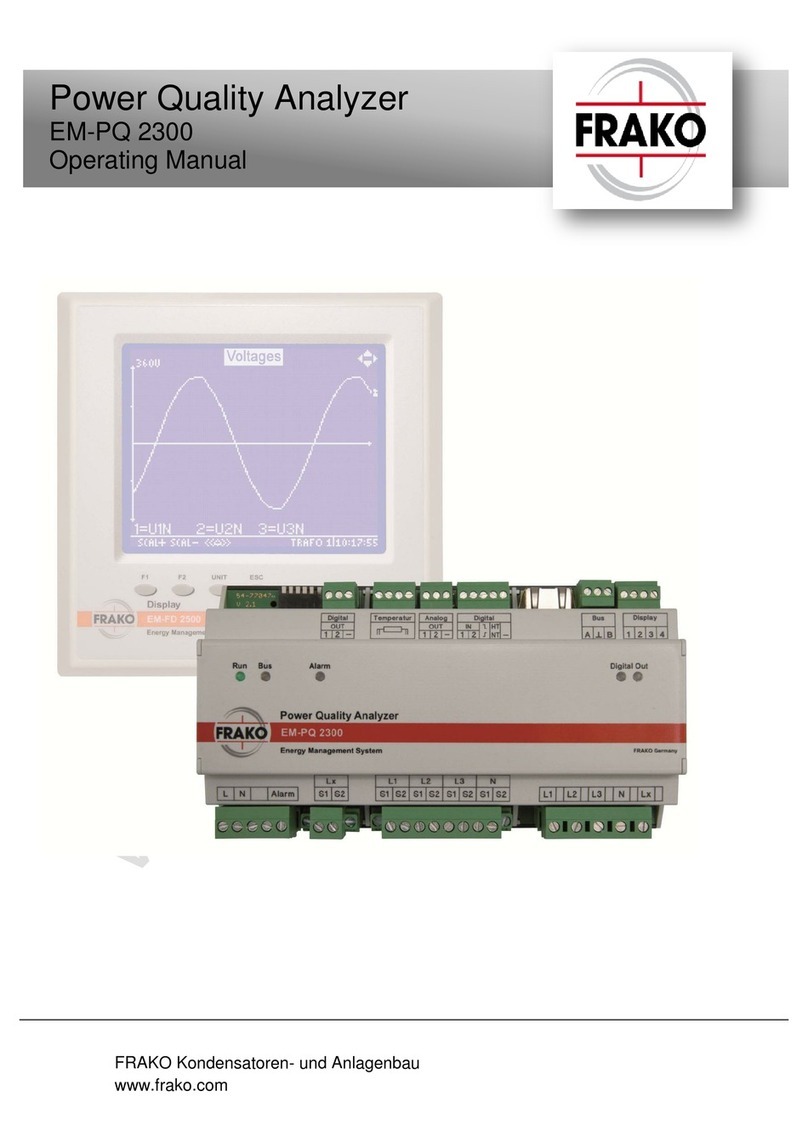
2 |
Power Quality Analyzer 1101 – PQA | Operating Manual | FRAKO
Contents
1 About this manual �������������������������������������������������������������������������������������4
1.1 Objective . . . . . . . . . . . . . . . . . . . . . . . . . . . . . . . . . . . . . . . . . . . . . . . . . . . . . 4
1.2 Safekeeping . . . . . . . . . . . . . . . . . . . . . . . . . . . . . . . . . . . . . . . . . . . . . . . . . . 4
1.3 Symbols used in this manual. . . . . . . . . . . . . . . . . . . . . . . . . . . . . . . . . . . . . . 4
1.4 Reference documents . . . . . . . . . . . . . . . . . . . . . . . . . . . . . . . . . . . . . . . . . . . 5
2 Safety ���������������������������������������������������������������������������������������������������������6
2.1 Intended use . . . . . . . . . . . . . . . . . . . . . . . . . . . . . . . . . . . . . . . . . . . . . . . . . . 6
2.2 Instrument-specific dangers . . . . . . . . . . . . . . . . . . . . . . . . . . . . . . . . . . . . . . 6
2.3 Management information. . . . . . . . . . . . . . . . . . . . . . . . . . . . . . . . . . . . . . . . . 7
2.4 Disclaimer . . . . . . . . . . . . . . . . . . . . . . . . . . . . . . . . . . . . . . . . . . . . . . . . . . . . 7
2.5 Relevant standards . . . . . . . . . . . . . . . . . . . . . . . . . . . . . . . . . . . . . . . . . . . . . 8
2.6 Repair . . . . . . . . . . . . . . . . . . . . . . . . . . . . . . . . . . . . . . . . . . . . . . . . . . . . . . . 8
3 Technical data �������������������������������������������������������������������������������������������9
4 Instrument description ���������������������������������������������������������������������������13
4.1 Function . . . . . . . . . . . . . . . . . . . . . . . . . . . . . . . . . . . . . . . . . . . . . . . . . . . . 13
4.2 Operation . . . . . . . . . . . . . . . . . . . . . . . . . . . . . . . . . . . . . . . . . . . . . . . . . . . 13
4.3 Password protection . . . . . . . . . . . . . . . . . . . . . . . . . . . . . . . . . . . . . . . . . . . 14
5 Installation �����������������������������������������������������������������������������������������������15
5.1 Mounting at the desired location . . . . . . . . . . . . . . . . . . . . . . . . . . . . . . . . . . 15
5.1.1 Preparing for installation. . . . . . . . . . . . . . . . . . . . . . . . . . . . . . . . . . . 15
5.1.2 Scope of supply. . . . . . . . . . . . . . . . . . . . . . . . . . . . . . . . . . . . . . . . . 15
5.1.3 Suitable location . . . . . . . . . . . . . . . . . . . . . . . . . . . . . . . . . . . . . . . . 15
5.1.4 Mounting the instrument . . . . . . . . . . . . . . . . . . . . . . . . . . . . . . . . . . 16
5.2 Electrical installation. . . . . . . . . . . . . . . . . . . . . . . . . . . . . . . . . . . . . . . . . . . . 17
5.2.1 Electrical installation procedure . . . . . . . . . . . . . . . . . . . . . . . . . . . . 17
5.2.2 Completing the electrical installation . . . . . . . . . . . . . . . . . . . . . . . . . 18
5.2.3 Specifications for the electrical connections . . . . . . . . . . . . . . . . . . . 19
5.2.4 Earth connection . . . . . . . . . . . . . . . . . . . . . . . . . . . . . . . . . . . . . . . . 19
5.2.5 Power supply. . . . . . . . . . . . . . . . . . . . . . . . . . . . . . . . . . . . . . . . . . . 19
5.2.6 Voltage measurement . . . . . . . . . . . . . . . . . . . . . . . . . . . . . . . . . . . . 20
5.2.7 Current measurement . . . . . . . . . . . . . . . . . . . . . . . . . . . . . . . . . . . . 21
5.2.8 Alarm. . . . . . . . . . . . . . . . . . . . . . . . . . . . . . . . . . . . . . . . . . . . . . . . . 21
5.2.9 Connection diagrams . . . . . . . . . . . . . . . . . . . . . . . . . . . . . . . . . . . . 22
5.3 Commissioning . . . . . . . . . . . . . . . . . . . . . . . . . . . . . . . . . . . . . . . . . . . . . . . 24
5.3.1 Preparations for start-up . . . . . . . . . . . . . . . . . . . . . . . . . . . . . . . . . . 24
5.3.2 Initial start-up. . . . . . . . . . . . . . . . . . . . . . . . . . . . . . . . . . . . . . . . . . . 24
6 Description of the menu �������������������������������������������������������������������������26
6.1 Main menu . . . . . . . . . . . . . . . . . . . . . . . . . . . . . . . . . . . . . . . . . . . . . . . . . . 26
6.2 Display. . . . . . . . . . . . . . . . . . . . . . . . . . . . . . . . . . . . . . . . . . . . . . . . . . . . . . 27






























